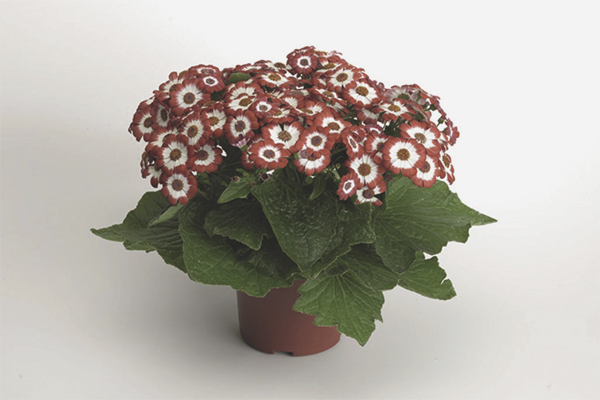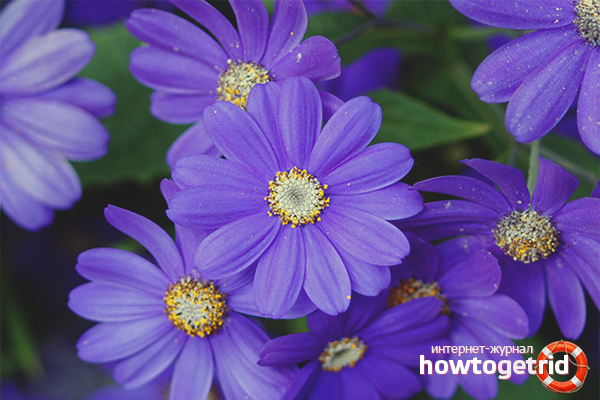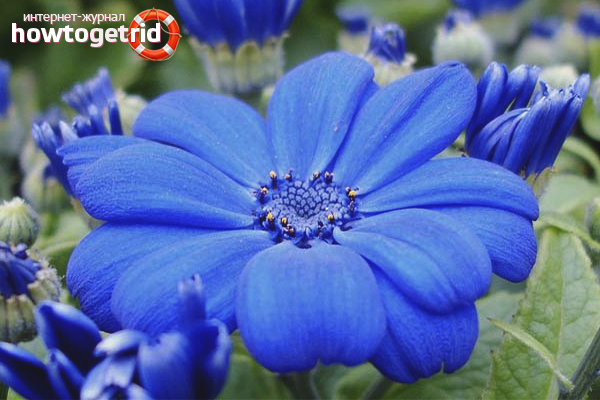The content of the article
Cineraria is a plant of the Aster family of the baptisers. There are annual and perennial species, the plant can be grassy or bush. His homeland are the Canary Islands (Spain). Currently, there are many varieties of cineraria, adapted to the colder climate than it is on the paradise islands. Hybrid varieties that bloom from November to March and have a beautiful bright color are grown in indoor conditions.
How to care for different varieties of cineraria
Cineraria looks incredibly impressive in mixborders and flower beds.
Seaside cineraria
Primorye Cineraria (Cineraria maritima) is known to many as a short, silver-gray plant with carved feathery leaves, which are decorated with flower beds and framed outdoor flower arrangements.
In the Mediterranean, in the homeland of this cineraria variety, it is grown as a biennial.But the plant does not tolerate frosts, so in a temperate climate it grows until October, and then it is dug out and thrown away. On the Mediterranean coast, it in the second year produces a yellow inflorescence of a coltsfoot or dandelion. They have no aesthetic value, therefore only non-flowering Cineraria maritima is used in floriculture. If in autumn it is covered with fallen leaves, the plant will survive the winter well, and from early spring it will delight with frosty-silver carved leaves. Features care for seaside cineraria are as follows:
- The plant loves the sun, because its homeland is sunny Italy, it grows poorly in the shade. Land in open well-lit areas.
- Does not need frequent watering, easily tolerates drought. It is quite possible to water only once during planting, this will be enough.
- It grows well on light loose soils, not necessarily nutritious.
- Cineraria maritime grown seeds as an annual, but in the winter you can cover up an annual plant. In the spring, the leaves are harvested, the pruned shoots are pruned, and the inflorescences are removed in the summer.
Cineraria bloody
Cineraria bloody (Senecio cruentus) is a bush-like plant with oval leaves and a variety of variegated inflorescences similar to daisies. Senecio cruentus has a variety of varieties, differing in size and method of care.
- Variety Grandiflora has petals with a white base and bright colored fringe. The plant reaches a height of 45 cm, therefore, needs support.
- Variety Stellata is a set of star-shaped inflorescences, forming a spreading crown. The plant has a tall, over 70 cm, trunk. This variety also requires support for growing.
- Variety Multiflora Nana has a compact shape and a short stem up to 40 cm. It does not need support.
Cineraria bloody is most often used as a pot culture. Care for her is as follows:
- monitor the temperature in the room, it should not exceed 18 degrees
- place the flower pot on a well-lit and ventilated window sill
- avoid drafts
- watering is done as the topsoil dries
- fertilizer for flowering plants every 2 weeks
- leaves sprayed in hot weather from a spray bottle
- faded flowers are removed
- during flowering, the plant is cleaned in a cool place, you can in the hallway.
Cineraria is elegant
Elegant Cineraria (Cineraria elegans) grows in nature in African countries. The leaves and stems are covered with sticky hairs, reaches a height of 60 cm, has a strong branching. Inflorescences in appearance resemble chamomile flowers bright exotic colors. In a temperate climate, cineraria graceful also caught on and fell in love with gardeners for their unpretentiousness and attractive appearance. It blooms not so magnificently as bloody cineraria, but not so exacting to the conditions of growth. The variety Ligulosus is a hybrid, terry inflorescences are painted with all shades of the rainbow. The Nanus variety does not grow higher than 25 cm, and it is more used as a pot home culture. Care for elegant cineraria as follows:
- Elegant Cineraria loves sunlight and heat, so it is placed on well-warmed window sills or in open sunny areas of the garden.
- It is enough to plant the plant immediately in the soil rich in organic fertilizers, and you do not need to think about periodic feeding.
- Take care of good drainage, elegant cineraria does not like stagnant water.
- The outdoor plant does not tolerate frost, even if it is covered with foliage or spruce paws.
- Limit watering, the plant lacks natural precipitation. Water only in case of drought.
Cineraria hybrid
Hybridi Cineraria (Cineraria hybrids) in appearance resembles a bush of violets. Rough and rugged leaves at the edges have a length of 15-20 cm, the whole bush is covered with many buds and basket-shaped flowers with a diameter of 5 cm, resembling daisies. The color of the flowers is two-color or monotonous (blue, blue, pink). Homeland cineraria hybrid are the Canary Islands, where the plant grows in the cool mountain forests. In temperate climates, it is grown in greenhouses. The plant reaches a height of 30-35 cm. The most common varieties of cineraria hybrid are:
- Variety Sympathy, the highest grade, reaching a height of 70 cm with a diameter of 8 cm flowers
- Double Variety has a two-tone color, has a height of 35-60 cm and a diameter of 5 cm flowers.
Caring for cineraria hybrid has its own characteristics:
- place the flowerpot on the windowsill facing north
- does not tolerate bright sunlight and direct rays
- The buds are laid at a temperature of 10 ° C, and during this period the pots are put on the balcony
- at the onset of flowering pot transferred to the room
- water the plant a lot and often on hot summer days
- put the pots in the pan and pour water there
- spray the leaves with water from a spray bottle
- the plant especially needs feeding, which should be done every week
What fertilizers should feed cineraria
Fertilizer "Agricola for indoor, garden flowers and alpine hills" is suitable for feeding both indoor and garden varieties of cineraria. Available in the form of sticks stuck into the ground. Under the influence of moisture contained in the soil, the plant is fed by macro-and micronutrients. Sticks protect the roots from rot and from harmful insects. The drug is convenient in the event that the country can not get out only on weekends.
Fertilizer "Agricola-Aqua for indoor plants" is added to the water and used for root feeding. It is a growth stimulator, saturating the soil with useful substances. Promotes increased flowering, stimulates the immune system of the plant.
Plant growth regulator "Growth moment for flowers" is an absolutely natural product, produced on the basis of yeast. Makes the plant more resistant to adverse conditions (drought, frost), reduces stress during transplantation, prolongs the flowering period and enhances the brightness of the color.
Liquid fertilizer “Oxidate peat for flowers” contains a 4% peat concentrate rich in amino acids and nutrients. The drug is safe for humans, flora and fauna, it is completely non-toxic. It is dissolved in water, brought under a root. Promotes growth and flowering, increases disease resistance and tolerance to adverse conditions.
Cineraria is a very beautiful plant. It can be grown in the country and at home. Choose for yourself a grade, considering possibilities and features of leaving. If the rules are followed, the plant will rejoice in bright abundant flowering for many years.













To send